Emmett Till was just 14 years old when he was kidnapped, beaten beyond recognition, shot, and thrown into a Mississippi river. But his brutal death was not in vain.
Emmett Till was just 14 years old in 1955 when a white woman accused him of wolf-whistling at her in a store in Mississippi. This alleged act would cost the young black boy his life just a few days later when the woman’s husband and his half-brother beat him so severely that he was unrecognizable before shooting him in the head.
The men responsible for the crime had multiple witnesses and mountains of evidence stacked against them, but in an unsurprising decision all too common in the Jim Crow era, an all-white jury cleared them of all charges.
Even though Emmett Till’s life ended far too soon and far too brutally, his story was just beginning. Soon the entire country would know Till’s name and see the grotesque remains of the boy’s body plastered across front pages. These images, as grisly as they were, caused thousands of people to devote themselves to the nascent Civil Rights Movement and embark on a mission to change the future of the United States forever.
The Story Of Emmett Till
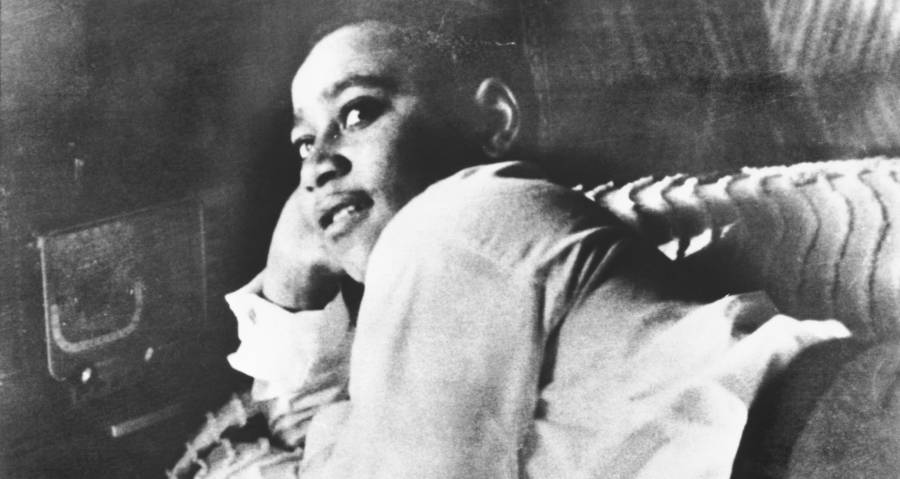
Bettmann/Getty ImagesA young Emmett Till lying on his bed.
Emmett Louis Till was born on July 25, 1941, in Chicago, Illinois. He was the only child of Louis and Mamie Till but never knew his father, who died in World War II. Till was raised by his single mother who often worked 12-hour days as a clerk for the Air Force to support herself and her son.
When Till was five years old, he contracted polio. He recovered but developed a stutter as a result.
According to his mother, Till was a happy and helpful boy, and she recalled how he once told her, “If you can go out and make the money, I can take care of the house.” He did just that by cooking and cleaning regularly.
Nicknamed “Bobo,” Till grew up in a middle-class neighborhood on the South Side of Chicago where he attended school and was always trying to make people laugh.
“Emmett was a funny guy all the time,” his former classmate Richard Heard said. “He had a suitcase of jokes he liked to tell. He loved to make people laugh. He was a chubby kid; most of the guys were skinny, but he didn’t let that stand in the way. He made a lot of friends at McCosh Grammar School, where we went to school.”
But everything changed for Emmett Till in the summer of 1955.
Life In The Jim Crow South
From the late 1800s to the 1960s, Jim Crow laws ruled the South, making racial segregation and discrimination completely legal.
The laws had been in place since the Reconstruction period following the Civil War but were expanded upon and ramped up around the turn of the century with the Supreme Court’s ruling in Plessy v. Ferguson in 1896. This ruling upheld the constitutionality of racial segregation and made laws establishing “separate but equal” spaces for whites and blacks.
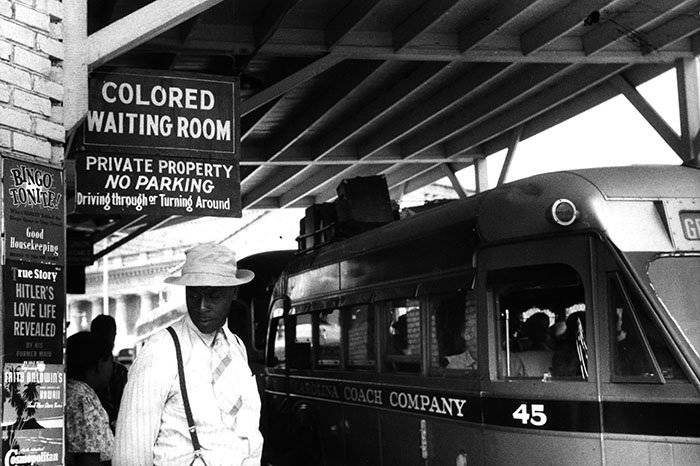
Library of CongressSigns such as this were commonplace in the South during the Jim Crow era.
These laws prohibited African-Americans from living in white neighborhoods and instituted separate water fountains, bathrooms, elevators, cashier windows, and many more public spaces.
Thanks in large part to these laws, many African-Americans moved north to escape Jim Crow and settled in cities where the restrictions were not as tight and the racism was not as all-encompassing as it was in the South.
Emmett Till’s family was one that had moved north, and when he ventured into the South in the summer of 1955, he quickly discovered what kind of a place it was for people like him.
What Happened To Emmett Till In Mississippi
In August of 1955, Till’s great uncle Moses Wright journeyed from Mississippi to Chicago to visit the family. Towards the end of his stay, Wright said that he was going to take Till’s cousin, Wheeler Parker, with him on his trip back down to Mississippi to see relatives there.
Till pleaded with his mother to let him go with them and after a little bit of convincing, his mother agreed. It was her son’s first time visiting the South and Mamie made sure to let him know that life in the South was much different than it was in Chicago.
According to Time, she told her son, “to be very careful… to humble himself to the extent of getting down on his knees.”
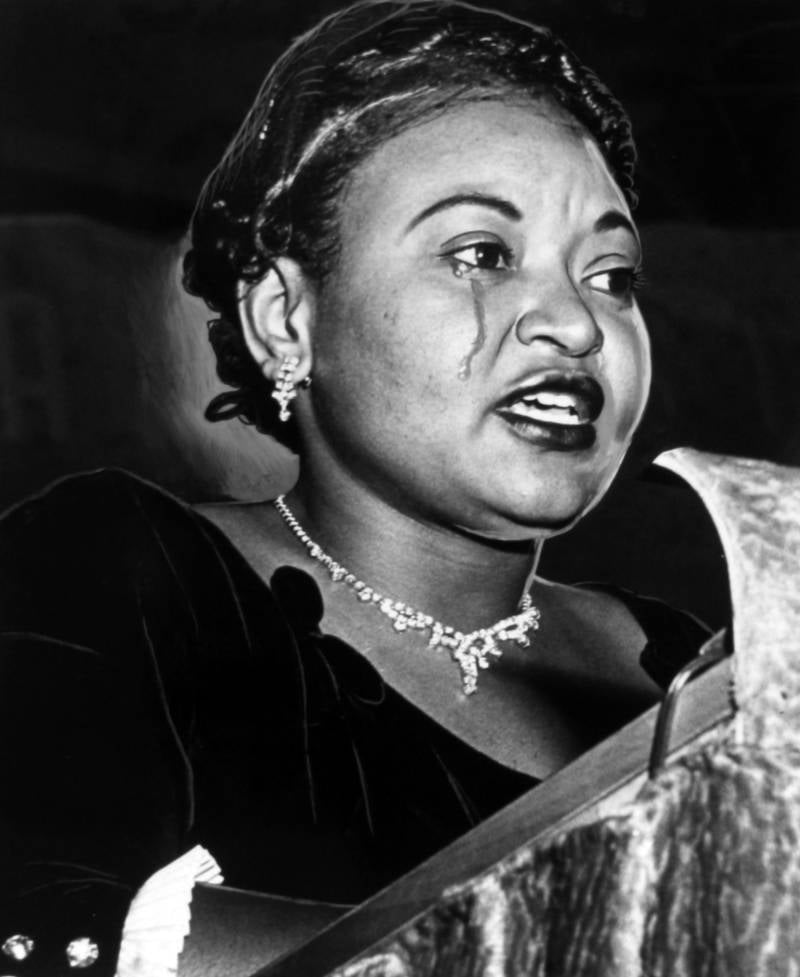
Afro American Newspapers/Gado/Getty ImagesMamie Bradley cries as she recounts her son’s death. Washington, D.C. October 22, 1955.
Just three days into his trip with his uncle and cousin to Money, Mississippi on August 24, 1955, Till and a group of his friends entered Bryant’s Grocery and Meat Market.
It is unclear precisely what happened inside the grocery store, but allegedly, Till bought some bubble gum and either wolf-whistled at, flirted with, or touched the hand of the store’s white female clerk, Carolyn Bryant, whose husband Roy also owned the store.
When Carolyn reported her story to Roy, he flew into a rage.
The Kidnapping And Murder Of Emmett Till
Roy Bryant returned home from a business trip a few days after the alleged incident between Till and his wife. After his wife told him what happened, Roy grabbed his half-brother J.W. Milam and headed to Wright’s house where Till was staying.
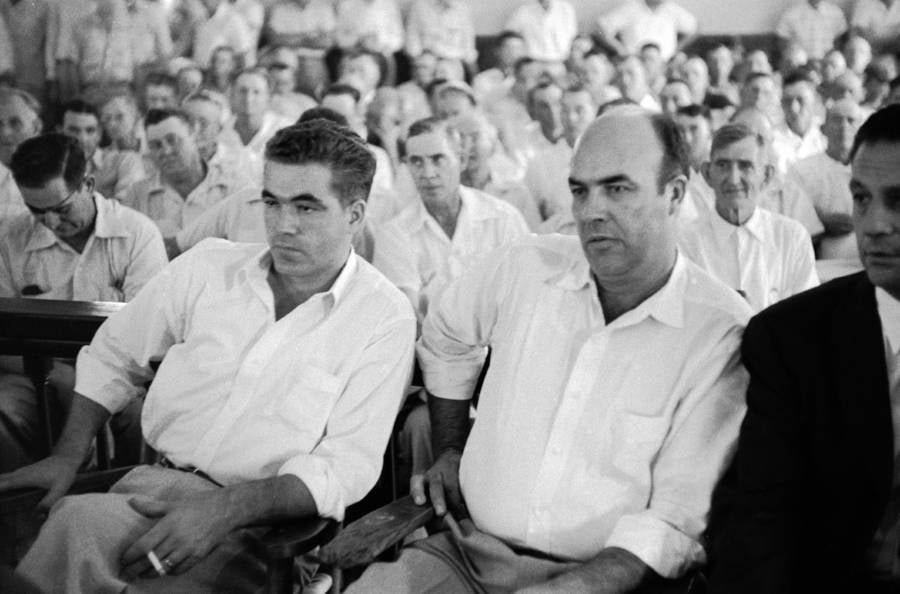
Ed Clark/The LIFE Picture Collection/Getty ImagesRoy Bryant (left) and J.W. Milam listen to testimony during their murder trial for the death of Emmett Till in the packed Tallahatchie County Courthouse in Sumner, Mississippi. September 1955.
Early in the morning on Aug. 28, 1955, the men barged into Wright’s home and demanded to see Till. They dragged him out of bed and ordered him into the back of their pickup truck. Wright pleaded with them to leave him alone.
“He’s only 14, he’s from up North,” Wright pleaded to the men according to PBS. “Why not give the boy a whipping, and leave it at that?” His wife offered them money, but they scolded her and told her to return to bed.
Wright led the men through the house to Till when Milam turned to Wright and threatened him, “How old are you, preacher?” Wright responded that he was 64. “If you make any trouble, you’ll never live to be 65.”
The men then kidnapped and savagely beat the 14-year-old boy. Once they ceased beating him beyond recognition, they shot him in the head. Then to keep Till’s body hidden, they tied a 75-pound cotton gin to his neck with barbed wire, hoping it would weigh him down when they tossed his body into the Tallahatchie River.

Wikimedia CommonsEmmett Till’s murder served to motivate Civil Rights activists like never before.
However, an 18-year-old named Willie Reed witnessed some of the event and heard Emmett Till’s screams.
The next day Reed was approached by a white man with a gun, who said, “Boy, did you see anything?” to which Reed said, “No.” The man then asked, “Did you hear anything?” Reed, who feared for his life, again said “no.”
Wright waited up to see what had happened to Emmett Till, and when he failed to return home, Wright set out in search for him. Three days later, Till’s corpse was recovered from the Tallahatchie River. The boy was so badly beaten that Wright could only identify him from the initial ring that his mother had given him before the trip.
Mamie Till requested to have her son’s remains sent back home to Chicago. Upon seeing her son’s mutilated body, Mamie decided to hold an open-casket funeral for her son so that the whole world could see what had been done to her son.
Mamie also invited Jet, an African-American magazine, to attend the funeral and take pictures of Till’s unrecognizable body. They soon published the horrific photos and the country took notice.
The Arrest And Trial Of Roy Bryant And J.W. Milam
Not even two weeks after his body was buried, Roy Bryant and J.W. Milam were on trial for the murder of Emmett Till. There were several witnesses to the killers’ actions that night, and they were thus the obvious suspects for Till’s murder and quickly apprehended.
When the trial began in September 1955, the national and international press came to Sumner, Mississippi to cover the events. Moses Wright, Willie Reed, and others sacrificed their safety and lives to testify against the two white men in court, saying that the men were indeed Till’s killers.
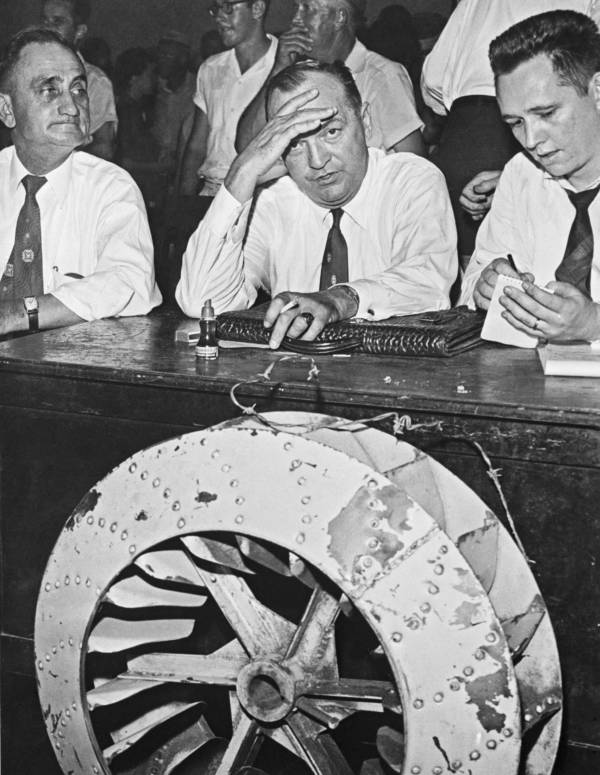
Bettmann/Getty ImagesProsecutors show the wheel used to weigh down the body of Emmett Till.
Meanwhile, Carolyn Bryant gave a fiery testimony accusing Till of verbally threatening her and grabbing her. Bryant’s statement was all that the all-white jury needed to hear. They took barely one hour to exonerate Till’s murderers as Bryant and Milam were acquitted of all charges, including kidnapping and murder.
One juror remarked that it would have taken even less time had they not stopped to drink a soda.
However, less than one year later, in January 1956, Bryant and Milam would confess to murdering Till in a Look magazine article titled, “The shocking story of approved killing in Mississippi.” The men got $4,000 for selling their story.
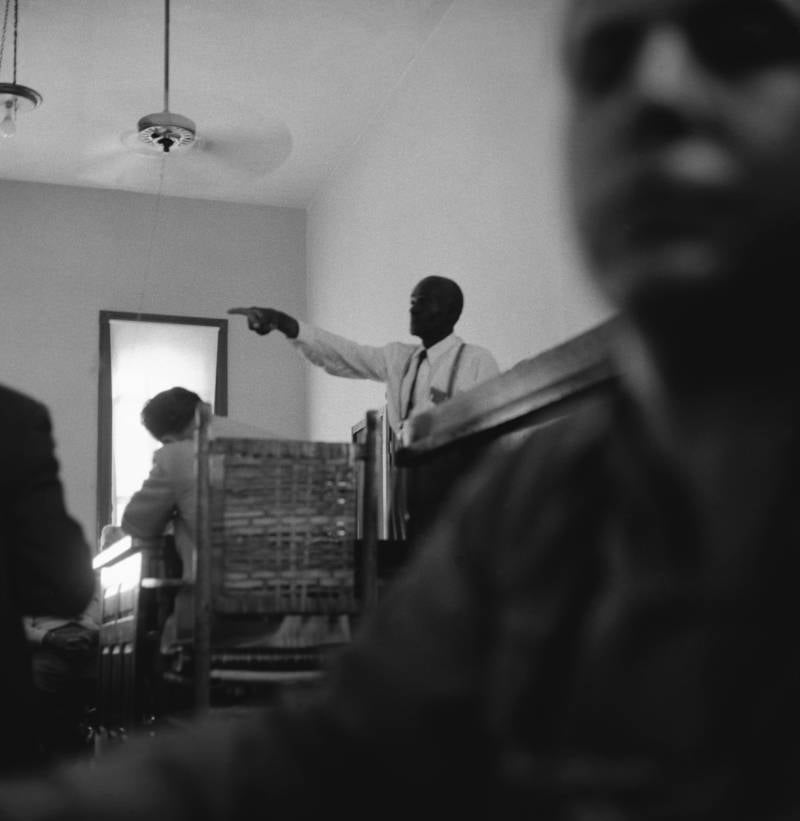
Bettmann/Getty ImagesIn answer to a question asking him to identify the men who came to his home on the night of August 28 and took young Emmett Till away with them, Moses Wright pointed and answered, “There they are.”
In the article, the pair gleefully admitted to murdering the 14-year-old boy and expressed no remorse for their heinous deed. They said that when they kidnapped Till, they only intended to beat him up, but decided to kill him when the teen refused to grovel. Milam explained his decision to Look saying:
“Well, what else could we do? He was hopeless. I’m no bully; I never hurt a n***** in my life. I like n*****s – in their place – I know how to work ’em. But I just decided it was time a few people got put on notice. As long as I live and can do anything about it, n*****s are gonna stay in their place… I stood there in that shed and listened to the n***** throw that poison at me, and I just made up my mind. ‘Chicago boy,’ I said. ‘I’m tired of ’em sending your kind down here to stir up trouble. Goddam you, I’m going to make an example of you – just so everybody can know how me and my folks stand.”
Because the men had already been tried and acquitted of Till’s murder, their callous confession garnered no lawful punishment.
The Impact Of Emmett Till’s Murder On The Civil Rights Movement
Mamie Till’s decision to display her son’s body in an open casket allowed the world to see just the sort of brutality that African-Americans could face — and consequently galvanized the Civil Rights Movement.
Once the nation saw those haunting images published in Jet magazine, they couldn’t ignore the brutality any longer.

Ed Clark/The LIFE Picture Collection/Getty ImagesRoy Bryant and J. W. Milam pose with their wives as they celebrate their acquittal for the murder of Emmett Till.
Just a few months after Emmett Till’s murder, Rosa Parks refused to give up her bus seat and started the Montgomery Bus Boycott which many people believe marked the start of the Civil Rights Movement in earnest. Reverend Jesse Jackson even told Vanity Fair that Parks informed him that Till was a huge factor in her deciding not to give up her seat.
“I asked Miss Rosa Parks [in 1988] why she didn’t go to the back of the bus, given the threat that she could be hurt, pushed off the bus, and run over because three other ladies did get up,” Jackson said. “She said she thought about going to the back of the bus. But then she thought about Emmett Till, and she couldn’t do it.”
The Los Angeles Times put it in perspective, saying, “If Rosa Parks showed the potential of defiance, [some historians] say, Emmett Till’s death warned of a bleak future without it.”
As Robin D. G. Kelly, chair of the History department at New York University told PBS:
“Emmett Till, in some ways, gave ordinary black people in a place like Montgomery, not just courage, but I think instilled them with a sense of anger, and that anger at white supremacy, and not just white supremacy, but the decision of the court to exonerate these men from murdering – for outright lynching this young kid – that level of anger, I think led a lot of people to commit themselves to the movement.”
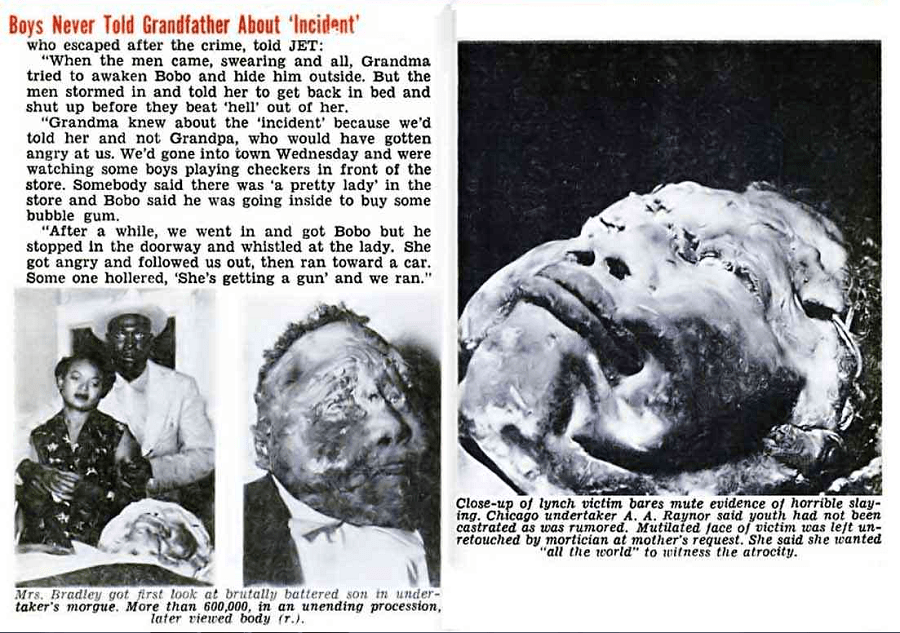
JetThe murder of Emmett Till left him unrecognizable. Images of his remains were published in Jet.
Indeed, to many, the story of Emmett Till represents a turning point. Scholar Clenora Hudson-Weems calls Till the “sacrificial lamb” of civil rights and Amzie Moore, an NAACP operative, believes that Till’s brutal killing was the start of the Civil Rights Movement altogether.
Till might not have been around to see the Civil Rights Movement make the kind of changes that would have spared his life, but his death was instrumental in getting the movement off the ground in the first place.
The Enduring Legacy Of Emmett Till’s Story
Even decades after his murder, the story of Emmett Till’s death continues to make headlines.
In perhaps the most significant recent revelation, Carolyn Bryant admitted in 2007 to Timothy Tyson, a Duke University senior research scholar, that she fabricated the majority of her testimony at trial.
One of the most damning things that she said during Emmett Till’s murder trial was that he made verbal and physical advances on her, but as she later told Tyson, “That part’s not true.”
At the time of her interview, Carolyn Bryant was in her 70s and seemed to feel some remorse for her part in the brutal murder — unlike her ex-husband, Roy. She told Tyson, “Nothing that boy did could ever justify what happened to him.”
Startlingly, in 2018, the Justice Department reopened the Till case for investigation, “based upon the discovery of new information.” This revelation brought new hope that justice would finally be served for those who were responsible for the death of the 14-year-old more than 60 years before.
Not only is the story of Emmett Till being thrust back into the spotlight, but his memory is as well.
In July 2018, a memorial sign for Till near the Tallahatchie River was defaced for the third time since being installed.
First, the sign was stolen and never recovered. Then, once replaced, was vandalized, this time in the form of dozens of bullet holes. Even after an additional replacement, the sign continued to face repeated vandalism.

Emmett Till Interpretive CenterThe second version of the memorial sign was vandalized with multiple bullet holes in 2016.
Patrick Weems, a co-founder of the Emmett Till Interpretive Center, told CNN that the attacks are fueled by hatred.
“Whether it was racially motivated or just pure ignorance, it’s still unacceptable,” Weems said. “It’s a stark reminder that racism still exists.”
Now that you’ve finished reading about the death of Emmett Till, discover the true story behind the iconic image of Elizabeth Eckford and Hazel Bryan. Then, relive the Civil Rights Movement in 55 powerful photos.






